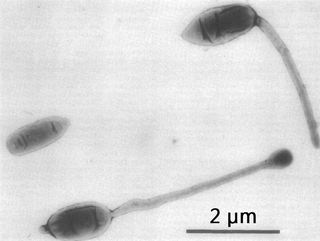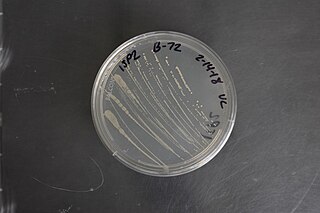Related Research Articles

Thermus is a genus of thermophilic bacteria. It is one of several bacteria belonging to the Deinococcota phylum. Thermus species can be distinguished from other genera in the family Thermaceae as well as all other bacteria by the presence of eight conserved signature indels (CSIs) found in proteins such as adenylate kinase and replicative DNA helicase as well as 14 conserved signature proteins (CSPs) that are exclusively shared by members of this genus.

The Hyphomicrobiaceae are a family of bacteria. Among others, they include Rhodomicrobium, a genus of purple bacteria.

The Acidithiobacillales are an order of bacteria within the class Acidithiobacillia and comprises the genera Acidithiobacillus and Thermithiobacillus. Originally, both were included in the genus Thiobacillus, but they are not related to the type species, which belongs to the Betaproteobacteria.
Thermithiobacillus is a genus of nonsporeforming, rod-shaped, Gram-negative bacteria. The name derives from the Latin thermae, for warm baths, and the Classical Greek θείος, theios for sulfur. The type species of this genus was previously assigned to the genus Thiobacillus, but it was reclassified on the basis of 16S rRNA analysis in 2000, creating this genus.
Rubrobacter is a genus of Actinomycetota. It is radiotolerant and may rival Deinococcus radiodurans in this regard.
Mycolicibacter kumamotonensis is a species of bacteria.
Etymology: kumamotonensis, pertaining to Kumamoto Prefecture in Japan, where the type strain was isolated.
Abiotrophia is a genus of lactic acid bacteria, a family in the phylum Bacillota (Bacteria).
Natrinema is a genus of the Natrialbaceae.
Acidomonas is a genus in the phylum Pseudomonadota (Bacteria). The genus contains single species, namely A. methanolica, formerly known as Acetobacter methanolicus
Agromyces is a genus in the phylum Actinomycetota (Bacteria).
Alishewanella is a genus in the phylum Pseudomonadota (bacteria).
Massilia dura is a Gram-negative, rod-shaped, non-spore-forming bacterium from the genus Massilia and family Oxalobacteraceae, which was isolated with Massilia albidiflava, Massilia plicata, and Massilia lutea from soil samples collected from southeast China. Colonies of M. dura are hard and compact and their color is pale white to yellow.
Aminobacter aganoensis is a bacterium from the genus of Aminobacter which was isolated from soil.
Aminobacter ciceronei is a bacterium from the genus of Aminobacter which was isolated from agricultural soil in California in the United States. Aminobacter anthyllidis has the ability to degrade Chloromethane and Bromomethane.
Aminobacter niigataensis is a bacterium from the genus of Aminobacter which was isolated from soil.
Pseudoxanthomonas is a genus of Gram-negative bacteria in the family Xanthomonadaceae from the phylum Pseudomonadota. This genus is closely related phylogenetically with the genera Xanthomonas, Xylella, and Stenotrophomonas. The genus was first distinguished in 2000 in biofilter samples, and was later emended by Lee et al. Some of the species in this genus are: P. mexicana, P. japonensis, P. koreensis, P. daejeonensis, and the type species P. broegbernensis.

Gluconobacter is a genus of bacteria in the acetic acid bacteria family. They prefer sugar-rich environments, so are sometimes found as a spoilage organism in beer. They are not known to be pathogenic but can cause rot in apples and pears. They are used alone or with acetobacter for microbial degradation of ethanol
Thalassotalea is an aerobic and chemo-organo-heterotrophic genus of bacteria from the family Colwelliaceae which occur in the ocean and in sea ice.
Terrabacter is a genus of Gram positive, strictly aerobic, non-sporeforming bacteria. The genus name is derived from Latin terra (earth), referring to the type species' original isolation from soil. The genus was first proposed in 1989; however, the type species Terrabacter tumescens was originally described in 1934, and had previously been classified in the genera Corynebacterium, Arthrobacter, and Pimelobacter. Terrabacter species have been isolated from soil, air and stone.
Alkalihalobacillus is a genus of gram-positive or gram-variable rod-shaped bacteria in the family Bacillaceae from the order Bacillales. The type species of this genus is Alkalihalobacillus alcalophilus.
References
- 1 2 LPSN lpsn.dsmz.de
- ↑ "Straininfo of Acidomonas methanolica". Archived from the original on 2014-02-23. Retrieved 2014-02-14.
- ↑ "Taxonomy Browser". Archived from the original on 2014-02-22. Retrieved 2014-02-14.
- ↑ Urakami, T.; Tamaoka, J.; Suzuki, K. -I.; Komagata, K. (1989). "Acidomonas gen. Nov., Incorporating Acetobacter methanolicus as Acidomonas methanolica comb. Nov". International Journal of Systematic Bacteriology. 39: 50–55. doi: 10.1099/00207713-39-1-50 .
- ↑ ATCC
- ↑ UniProt